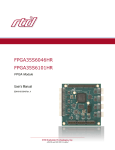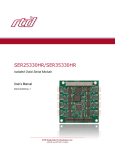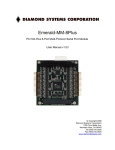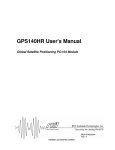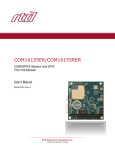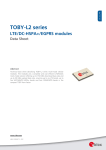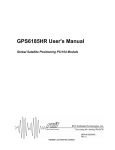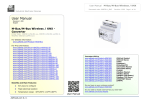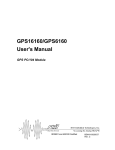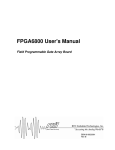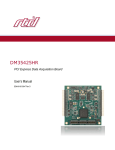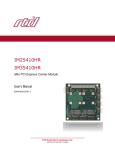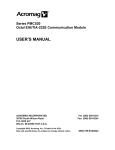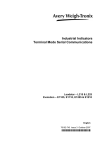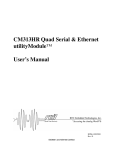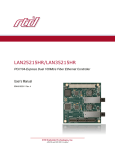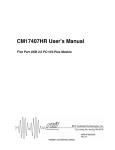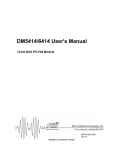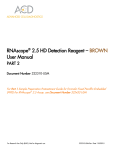Download CM17320HR User`s Manual - RTD Embedded Technologies, Inc.
Transcript
CM17320HR User's Manual Octal RS-232/422/485 PC/104-Plus Module BDM-610020049 Rev E ISO9001 and AS9100 Certified CM17320HR User's Manual RTD EMBEDDED TECHNOLOGIES, INC. 103 Innovation Blvd State College, PA 16803-0906 Phone: +1-814-234-8087 FAX: +1-814-234-5218 E-mail [email protected] [email protected] Web Site http://www.rtd.com Page 2 of 26 Manual Revision History Rev A New manual Rev B Added User Oscillator Rev C (01/31/2008) Added a section about supported baud rates. Added a diagram of the User Oscillator. Added information about COM port numbering in Windows. Added section on COM port enumeration for application developers. Rev D (08/13/2008) - Added the IDAN-CM17320 Dimensions and Pinout section, which replaces the (previously separate) IDAN Manual, IDM-650020032. - Corrected the IDAN connector pinout, which was listed incorrectly in IDM-650020032 rev A. - Added information about RTD pre-installed User Oscillators - Expanded the board block diagram to clarify the oscillator operation - Renamed the jumper designations for the signal conditioning jumpers. They now use the designations printed on the board silk, rather than the JPxx designation from the schematic. - Improved the Connector and Jumper Locations diagram. - Changed the name of the RS-422/485 Transmitter control section to more accurately indicate its purpose. Rev E (8/17/2009) - Added spec for External clock input - Added second mode jumper to get RS-422 with drivers always enabled and RS-485 with inverted RTS driver enable modes in addition to RS232 and RS-422/485 (now just RS-485 mode) with RTS driver enable modes Published by: RTD Embedded Technologies, Inc. 103 Innovation Boulevard State College, PA 16803 Copyright 2006 by RTD Embedded Technologies, Inc. All rights reserved The RTD Embedded Technologies Logo is a registered trademark of RTD Embedded Technologies. dspModule, cpuModule, and utilityModule are trademarks of RTD Embedded Technologies. PC/104, PC/104-Plus, and PCI-104 are registered trademarks of the PC/104 Page 3 of 26 Consortium. All other trademarks appearing in this document are the property of their respective owners. Page 4 of 26 Table of Contents Introduction ...................................................................................................................................... 7 Product Overview......................................................................................................................... 7 Board Features ............................................................................................................................ 7 I/O Interfaces................................................................................................................................ 7 Available Options ......................................................................................................................... 7 Getting Technical Support ........................................................................................................... 8 Hardware Description ...................................................................................................................... 9 Block Diagram.............................................................................................................................. 9 Supported Baud Rates................................................................................................................. 9 Board Connections ........................................................................................................................ 11 Connector and Jumper Locations .............................................................................................. 11 User Oscillator, U3 ..................................................................................................................... 11 Serial Port Connectors, CN4-CN11 ........................................................................................... 12 First serial port, CN4 .............................................................................................................. 12 RS-232 Serial Port Mode (Default) ..................................................................................... 12 RS-422/485 Serial Port Mode............................................................................................. 13 Second serial port, CN5 ......................................................................................................... 14 Third serial port, CN6 ............................................................................................................. 14 Fourth serial port, CN7 ........................................................................................................... 14 Fifth serial port, CN8 .............................................................................................................. 14 Sixth serial port, CN9 ............................................................................................................. 14 Seventh serial port, CN10 ...................................................................................................... 14 Eighth serial port, CN11 ......................................................................................................... 14 Jumper Settings ......................................................................................................................... 14 PCI Board Selector, SW1 .......................................................................................................... 16 Board Installation ........................................................................................................................... 17 Installing the Hardware .............................................................................................................. 17 Static Precautions .................................................................................................................. 17 Steps for Installing.................................................................................................................. 17 Page 5 of 26 Installing the Software................................................................................................................ 17 Software Programming.................................................................................................................. 19 API Interface .............................................................................................................................. 19 COM Port Numbering ................................................................................................................ 19 Base Address and Register Mapping ........................................................................................ 19 Enabling the RS-422/485 Transmitter........................................................................................ 19 Interrupts .................................................................................................................................... 20 Additional Information .................................................................................................................... 21 Serial Port Programming............................................................................................................ 21 Interrupt Programming ............................................................................................................... 21 Exar XR17D158 PCI Bus Octal UART ...................................................................................... 21 CM17320HR Board Specifications ................................................................................................ 22 Physical Attributes ..................................................................................................................... 22 Operating Conditions.............................................................................................................. 22 IDAN-CM17320HRS Dimensions and Pinout ............................................................................... 23 IDAN Frame ............................................................................................................................... 23 IDAN Connectors ....................................................................................................................... 24 37-pin “D” Female Connectors ............................................................................................... 24 Serial Ports 1-4 (Front)........................................................................................................... 24 Serial Ports 5-8 (Back) ........................................................................................................... 25 Limited Warranty............................................................................................................................ 26 Page 6 of 26 Introduction Product Overview The CM17320HR is designed to provide eight independent PCI serial ports with RS-232, RS-422, or RS-485 interfaces for PC/104-Plus based systems. Board Features o o o o Eight versatile serial port interfaces Jumper-selectable RS-232, RS-422 drivers always enabled, RS-485 with RTS driver enable and RS-485 with inverted RTS driver enable operation Supports all standard RS-232 serial port signals (RTS, CTS, etc). Functionally compatible with standard PC 16C550 UARTs Exar XR17D158 Octal PCI UART 32-bit PCI target 16C550 compatible 5G register set 64 byte transmit and receive FIFOs Programmable date rate with prescaler 14.7456 MHz crystal Standard PC serial port baud rates supported Up to 921,600 baud RS-422/485 (prescaler = 1) Up to 230,400 baud RS-232 (prescaler = 4) User oscillator option Enables support for non-standard baud rates up to 6.25 Mbps +3.3 V or 5 V Oscillators, 50 MHz max 8-pin DIP package (4 pins used) Board may be ordered with a custom oscillator preinstalled. PC/104-Plus compliant Universal (3.3V or 5.0V) PCI signaling I/O Interfaces o o o Eight 10-pin DIL serial port connectors 0.1” Pin Spacing Can be cabled directly to a 9-pin “D” connector PC/104-Plus (PCI) stack-through bus connector PC/104 (ISA) stack-through bus connector Available Options The CM17320HR may be purchased as either a board-level product, or as an IDAN module for integration into an RTD IDAN system. Cable kits are also available. Part Number Description CM17320HR Octal Serial Port Peripheral Module CM17320HR-xxx.xxxMHz CM17320HR with pre-installed oscillator for custom baud rates (xxx.xxx specifies the frequency) Page 7 of 26 XK-CM30 Quad Serial Port Cable Kit (To connect all 8 ports, purchase two XK-CM30s) IDAN-CM17320HRS CM17320HR mounted in an IDAN frame May also specify a custom oscillator frequency. IDAN-CM17320HRS/xxx.xxxMHz IDAN-XKCM33 IDAN-CM17320HRS with pre-installed oscillator for custom baud rates (xxx.xxx specifies the frequency) IDAN Multi Serial Port Cable (4 ports) (To connect all 8 ports, purchase two IDAN-XKCM33s) In addition to the above ordering options, RTD can also provide the CM17320HR with various customizations (e.g. conformal coating, custom connectors, soldered jumpers, etc). Contact RTD’s sales department ([email protected]) for more information. Getting Technical Support If you are having problems with your system, please try the following troubleshooting steps: • Simplify the System – Remove modules one at a time from your system to see if there is a specific module that is causing a problem. • Swap Components – Try replacing parts in the system one-at-a-time with similar parts to determine if a part is faulty or if a type of part is configured incorrectly. If problems persist, or you have questions about configuring this product, obtain the PCI BIOS listing information of the CM17320HR and other modules in the system. After you have this information, contact RTD Embedded Technologies via the following methods: Phone: +1-814-234-8087 E-Mail: [email protected] Be sure to check the RTD web site (http://www.rtd.com) frequently for product updates, including newer versions of the board manual and application software. Page 8 of 26 Hardware Description PC/104-Plus Connector (CN3) Block Diagram PCI Bus Exar XR17D158 PCI UART Signal Conditioning (Jumper-Controlled) COM a RS-232/422/485 CN4 COM b RS-232/422/485 CN5 COM c RS-232/422/485 CN6 COM d RS-232/422/485 CN7 COM e RS-232/422/485 CN8 COM f RS-232/422/485 CN9 COM g RS-232/422/485 CN10 COM h RS-232/422/485 CN11 14.7456 MHz Oscillator UART Input Clock Oscillator Select Jumper (JP2) User Oscillator (U3) +5V U3 VCC +3.3V User Oscillator Power Jumper (JP27) Figure 1 CM17320 Block Diagram Supported Baud Rates When using the standard 14.7456 MHz oscillator, the CM17320HR supports the standard baud rates of PC serial port (e.g. 2400, 9600, 19.2k, etc). The CM17320HR can also support nonstandard baud rates via a User Oscillator. The baud rate of a serial port is set by dividing the input clock (typically 14.7546MHz). For the Exar XR17D158, there are two dividers to specify. First is the Prescaler (MCR Bit 7), divides the input clock by either 1 or 4. Second is the Baud Rate Generator, which further divides the frequency further to achieve the desired baud rate. The Baud Rate Generator can be set to a 16 value between 1 and (2 -1). Page 9 of 26 Note: For more information on programming the Prescaler and Baud Rate Generator, consult the XR17D158 datasheet. The Baud Rate Generator divisor can be calculated by one of the following equations depending on sampling of receiver of 8 or 16: Divisor = (INPUT_CLOCK / PRESCALER) / (DESIRED_BAUD_RATE x 16) or Divisor = (INPUT_CLOCK / PRESCALER) / (DESIRED_BAUD_RATE x 8) For example, if one wants to use a baud rate of 115.2K, Prescale divisor of 4, and receiver sampling of 16, the Baud Rate Generator divisor would be: (14745600 / 4) / (115200 x 16) = 2 If the desired baud rate can not be expressed as a whole number divisor, it may be necessary to use a different input clock. This can be done with a User Oscillator. A user-specified oscillator can be installed in U3. The max frequency for the user oscillator is 50 MHz and the max baud rate for the chip is 6.25 Mbps. Alternatively, RTD can preinstall several common oscillator frequencies. Page 10 of 26 Board Connections Connector and Jumper Locations The following diagram shows the location of all connectors and jumpers on the CM17320HR. Future revisions of the CM17320HR may have cosmetic differences. For a description of each jumper and connector, refer to the following sections. PC/104-Plus PCI Bus CN8 th 5 serial port CN7 th 4 serial port CN9 th 6 serial port CN6 rd 3 serial port CN10 th 7 serial port CN5 nd 2 serial port CN11 th 8 serial port CN4 st 1 serial port JP2 – Oscillator Select JP27 – User Oscillator Power SW1 PCI Slot Selector PC/104-Plus ISA Bus Serial Port Signal Conditioning (4 jumpers per port) Mode A & B = Signaling Mode R = RxD Termination C = CTS Termination U3 – User Oscillator Figure 2 – CM17320 Connector and jumper locations User Oscillator, U3 The board has a position for a half size, 8-pin DIP, user oscillator. This device can be either a 5 volt or 3.3 volt oscillator and is configured with jumper JP27. Jumper JP2 selects either the 14.7456 MHz oscillator or the user oscillator. All serial ports use the same oscillator. U3 pin 1 is Page 11 of 26 pulled high with a 10K ohm resistor to enable tri-state oscillators. The max frequency is 50MHz which will result in a max baud rate of 6.25Mbps. User Oscillator U3 Pinout Pin 4 VCC (Set by JP27) Pin 3 CLOCK Pin 2 GND Pin 1 OE Serial Port Connectors, CN4-CN11 The following sections describe the external I/O connections of the CM17320HR board. For information on the I/O connections for the IDAN version, refer to the IDAN-CM17320HRS section later in this manual. First serial port, CN4 The first serial port is implemented on connector CN4. It can be configured as a PC compatible full duplex RS-232 port, full duplex RS-422 with drivers always enabled, RS-485 with RTS driver enable, or RS-485 with inverted RTS driver enable by the “Mode A and B” jumpers. See Table 5 – Jumper Settings for details. RS-232 Serial Port Mode (Default) The full-duplex RS-232 mode is the default setting on the utilityModule. With this mode enabled, connector CN4 must be connected to RS-232 compatible devices. The following table gives the connector pinout and shows how to connect to an external serial connector, either DB25 or DB9. Table 1 Connector CN4 in RS-232 Mode (I) CN4 Pin Signal Function In/out DB25 DB9 1 DCD Data Carrier Detect In 8 1 2 DSR Data Set Ready In 6 6 3 RXD Receive Data In 3 2 4 RTS Request To Send Out 4 7 5 TXD Transmit Data Out 2 3 6 CTS Clear To Send In 5 8 7 DTR Data Terminal Ready Out 20 4 Page 12 of 26 8 RI Ring Indicate In 22 9 9,10 GND Signal Ground -- 7 5 Facing the connector pins, the pinout is pictured in the following, Table 2 Connector CN4 in RS-232 Mode (II) 9 7 5 3 1 GND DTR TXD RXD DCD GND RI CTS RTS DSR 10 8 6 4 2 RS-422, RS-485 RTS, RS-485 Inverted RTS Serial Port Modes When using RS-422 or RS-485 mode, you can use the port in either half-duplex (two-wire) or fullduplex (four-wire) configurations. For half-duplex (2-wire) operation, you must connect RXD+ to TDX+ and connect RXD- to TXD-. Note: 120-ohm termination resistors for the RxD and CTS signals are provided on the utilityModule. Termination is usually necessary on all RS-422 receivers and at the ends of the RS-485 bus. If the termination resistor is required, it can be enabled by closing jumpers labeled “R” and “C” for the corresponding port. For more information, refer to the Jumper Settings table later in this chapter. The following table gives the pinout of connector CN4 when RS-422 or RS-485 modes are enabled. Table 3 Connector CN4 in RS-422/485 Mode (I) CN3 Pin Signal Function In/out DB9 1 RTS- Request to send (-) Out 1 2 RTS+ Request to send (+) Out 6 3 RXD- Receive Data (-) In 2 4 TXD+ Transmit Data (+) Out 7 5 TXD- Transmit Data(-) Out 3 6 RXD+ Receive Data (+) In 8 7 CTS- Clear to send (-) In 4 8 CTS+ Clear to send (+) In 9 9,10 GND Signal Ground -- 5 Page 13 of 26 Facing the connector pins, the pinout is pictured in the following table. Table 4 Connector CN4 in RS-422/485 Mode (II) 9 7 5 3 1 GND CTS- TXD- RXD- RTS- GND CTS+ RXD+ TXD+ RTS+ 10 8 6 4 2 Second serial port, CN5 Please refer to the previous section on the first COM port, CN4 for the description. Third serial port, CN6 Please refer to the previous section on the first COM port, CN4 for the description. Fourth serial port, CN7 Please refer to the previous section on the first COM port, CN4 for the description. Fifth serial port, CN8 Please refer to the previous section on the first COM port, CN4 for the description. Sixth serial port, CN9 Please refer to the previous section on the first COM port, CN4 for the description. Seventh serial port, CN10 Please refer to the previous section on the first COM port, CN4 for the description. Eighth serial port, CN11 Please refer to the previous section on the first COM port, CN4 for the description. Jumper Settings The following sections describe the jumper configuration options available on the CM17320HR. For a reference that shows the location of each set of jumpers, refer to the diagram of the CM17320HR at the beginning of this chapter. The default factory jumper settings are listed in the following table: Page 14 of 26 Table 5 – Jumper Settings Jumper Description JP1 Bypass PCI bus EEPROM JP2 14.7456 MHz Oscillator or User Oscillator Mode A Mode B First serial port mode CN4 R C Mode A Mode B First serial port RxD termination in RS-422/485 First serial port CTS termination in RS-422/485 Second serial port mode CN5 R C Mode A Mode B Second serial port RxD termination in RS-422/485 Second serial port CTS termination in RS-422/485 Third serial port mode CN6 R C Mode A Mode B Third serial port RxD termination in RS-422/485 Third serial port CTS termination in RS-422/485 Fourth serial port mode CN7 R C CN8 Mode A Mode B R Fourth serial port RxD termination in RS-422/485 Fourth serial port CTS termination in RS-422/485 Fifth serial port mode Fifth serial port RxD termination in RS-422/485 Function and Default Setting 1-2 for Normal operation (default) 2-3 Factory use only 1-2 14.7456 MHz (default) 2-3 User Oscillator Note: Be sure to set JP27 if using a User Oscillator. B A Mode Open Open RS-232 (Default) Open Close RS-485 RTS driver enable Close Open RS-485 RTS inv. driver enable Close Close RS-422 drivers enabled Open No termination (default) Closed 120 Ohm Termination Open No termination (default) Closed 120 Ohm Termination B A Mode Open Open RS-232 (Default) Open Close RS-485 RTS driver enable Close Open RS-485 RTS inv. driver enable Close Close RS-422 drivers enabled Open No termination (default) Closed 120 Ohm Termination Open No termination (default) Closed 120 Ohm Termination B A Mode Open Open RS-232 (Default) Open Close RS-485 RTS driver enable Close Open RS-485 RTS inv. driver enable Close Close RS-422 drivers enabled Open No termination (default) Closed 120 Ohm Termination Open No termination (default) Closed 120 Ohm Termination B A Mode Open Open RS-232 (Default) Open Close RS-485 RTS driver enable Close Open RS-485 RTS inv. driver enable Close Close RS-422 drivers enabled Open No termination (default) Closed 120 Ohm Termination Open No termination (default) Closed 120 Ohm Termination B A Mode Open Open RS-232 (Default) Open Close RS-485 RTS driver enable Close Open RS-485 RTS inv. driver enable Close Close RS-422 drivers enabled Open No termination (default) Closed 120 Ohm Termination Page 15 of 26 Jumper C Mode A Mode B Description Fifth serial port CTS termination in RS-422/485 Sixth serial port mode CN9 R C Mode A Mode B Sixth serial port RxD termination in RS-422/485 Sixth serial port CTS termination in RS-422/485 Seventh serial port mode CN10 R C Mode A Mode B CN11 R C JP27 Seventh serial termination in Seventh serial termination in port RxD RS-422/485 port CTS RS-422/485 Eighth serial port mode Eighth serial port RxD termination in RS-422/485 mode Eighth serial port CTS termination in RS-422/485 mode User Oscillator power source selection Function and Default Setting Open No termination (default) Closed 120 Ohm Termination B A Mode Open Open RS-232 (Default) Open Close RS-485 RTS driver enable Close Open RS-485 RTS inv. driver enable Close Close RS-422 drivers enabled Open No termination (default) Closed 120 Ohm Termination Open No termination (default) Closed 120 Ohm Termination B A Mode Open Open RS-232 (Default) Open Close RS-485 RTS driver enable Close Open RS-485 RTS inv. driver enable Close Close RS-422 drivers enabled Open No termination (default) Closed 120 Ohm Termination Open No termination (default) Closed 120 Ohm Termination B A Mode Open Open RS-232 (Default) Open Close RS-485 RTS driver enable Close Open RS-485 RTS inv. driver enable Close Close RS-422 drivers enabled Open No termination (default) Closed 120 Ohm Termination Open No termination (default) Closed 120 Ohm Termination 1-2 +5V (default) 2-3 +3.3V PCI Board Selector, SW1 The CM17320HR uses a rotary switch to select the PCI slot. Before you can use this module you have to set the PCI board selector switch. The procedure is if this module is the first module from the CPU module select ’0,’ if it is the second module select ’1,’ etc. Positions 4 - 7 are simply repeats of positions 0 – 3. 7 0 1 6 5 2 4 3 Figure 3: PCI Selector Rotary Switch PCI Board Selector Page 16 of 26 Board Installation Installing the Hardware The CM17320HR can be installed into a PC/104-Plus or PCI-104 stack. It can be located almost anywhere in the stack, above or below the CPU as long as all PCI bus constraints are met. Static Precautions Keep your board in its antistatic bag until you are ready to install it into your system! When removing it from the bag, hold the board at the edges, and do not touch the components or connectors. Handle the board in an antistatic environment, and use a grounded workbench for testing and handling of your hardware. Steps for Installing 1. Shut down the PC/104-Plus system and unplug the power cord. 2. Ground yourself with an anti-static strap. 3. Set the PCI Slot Selector as described in the previous chapter. 4. If any other PCI add-on cards are to be included in the stack, be sure that their PCI slot numbers are configured correctly (Slot 0 for the board closest to the CPU, Slot 1 for the next board, etc). 5. Line up the pins of the CM17320’s PC/104 and PC/104-Plus connectors with the corresponding bus connectors of the stack. Make sure that both connectors are lined up. 6. Apply pressure to both bus connectors and gently press the board onto the stack. The board should slide into the matching bus connectors. Do not attempt to force the board, as this can lead to bent/broken pins. 7. If any boards are to be stacked above the CM17320, install them. 8. Attach any necessary cables to the PC/104-Plus stack. 9. Re-connect the power cord and apply power to the stack. 10. Boot the system and verify that all of the hardware is working properly. Note: If multiple PCI devices are configured to use the same PCI slot number, the system may not boot. Installing the Software The CM17320HR uses a PCI-based UART, not the standard ISA-based UART found in most PC motherboards. Therefore, it may be necessary to install software before the board will be recognized by the operating system. RTD provides drivers for several popular operating systems. This software is provided on disk with the board, and is also available for download from the RTD web site (http://www.rtd.com). Page 17 of 26 Note: Before installing any drivers, it is recommended that you visit the RTD web site to check for a newer version. The actual procedure for installing the software will depend on the operating system. Consult the documentation provided with the software for installation instructions. Once the drivers are installed, all eight ports should be available as standard serial ports (a.k.a. COM ports) to the operating system. At that point, application software should be able to access and control the serial ports. Note: When the CM17320HR is installed under Windows, it typically uses a contiguous set of COM port numbers (e.g. COM3-COM10). If the CM17320HR is installed in a system with more than two COM ports, there may be overlap between the COM port numbers. It may be necessary to re-number the existing COM ports to avoid conflicts with the CM17320HR. Consult the Windows driver documentation for more information. Page 18 of 26 Software Programming API Interface Once the drivers for the CM17320HR have been properly loaded, all eight RS-232/422/485 ports should be available as standard serial ports. All eight ports can then be controlled using the standard serial port interfaces built into the operating system. A description of serial port programming for operating systems is beyond the scope of this manual. Consult the operating system documentation for information on how to interface with serial ports via software. COM Port Numbering Serial ports (aka COM ports) are typically assigned numbers by the operating system (e.g. COM1). These numbers are typically dynamically assigned by the operating system. However, different applications may enumerate the COM ports differently, assigning different port numbers (e.g. COM3-10 vs COM5-12). When developing your own serial port application, consult your operating system’s documentation for the proper method of enumerating COM ports. Note: Some applications are written to assume that no more than four COM ports are present in a system. These applications may have compatibility issues with the Exar PCI UART. Base Address and Register Mapping The CM17320HR exposes all of the registers available on the Exar XR17D158. The register set of the XR17D158 mimics the standard 16C550 UART register map. However, the XR17D158 contains some additional registers not found in a typical ISA-based UART. Additionally, the base address of the CM17320HR’s serial ports will be different than the standard PC serial port locations (0x3F8, 0x2F8, etc). The CM17320HR is a memory mapped device. Since it is PCI-based, it may be mapped to any location within the 4GB address space of the CPU. The base address of PCI devices is determined by the CPU’s BIOS and operating system at boot time. The register-level differences between the CM17320HR and a standard 16C550 UART should be abstracted via the software drivers. Most users will not need to concern themselves with the actual registers of the board. If one is interested in directly accessing the registers of the board, consult the XR17D158 data sheet available from Exar. Enabling the RS-422/485 Transmitter See Table 5 – Jumper Settings for mode jumper settings. When using the serial port in RS-422 or RS-485 mode, the serial receiver for RxD (receive data) is always enabled. In RS-422 mode the driver is always enabled, however in RS-485 mode the driver for TxD (transmit data) is enabled and disabled under software control in the following two ways. In RS-485 RTS driver enable mode the transmitter is enabled by manipulating the Request to Send (RTS) signal of the serial port controller. This signal is controlled by writing bit 1 of the Modem Control Register (MCR) as follows: Page 19 of 26 • If MCR bit 1 = 1, then RTS = 0, and serial transmitter is disabled • If MCR bit 1 = 0, then RTS = 1, and serial transmitter is enabled If you are using the RS-485 inverted RTS driver enable mode these settings will be reversed as follows: • If MCR bit 1 = 1, then RTS = 0, and serial transmitter is enabled • If MCR bit 1 = 0, then RTS = 1, and serial transmitter is disabled If you are using the handshaking signals in RS-422/485 mode, the serial receiver for CTS (clear to send) is always enabled, and the serial transmitter for RTS (request to send) is always enabled. The exact software method for toggling RTS will depend on your operating system. Consult your operating system’s programming documentation for information on how to do this. "NOTE: Many serial communication programs (e.g. Windows HyperTerminal) do not assert RTS while transmitting. When using these programs, make sure jumper that enables the transmitters all the time is installed. If using a multi-drop bus such as RS485, the software will have to be modified to toggle RTS to enable the transmit drivers.” Interrupts Since the CM17320HR is a PCI device, it is capable of sharing interrupts with other PCI devices. Interrupt sharing is a normal part of PCI operation, and a required part of the PCI specification. Note that any Interrupt Service Routines developed for the CM17320HR must be properly written to support interrupt sharing. The CM17320HR uses one PCI interrupt for all eight serial ports. The actual IRQ number will be set by the CPU’s BIOS and operating system at boot time. Since the XR17D158 has all the capabilities of a standard 16C550 UART, it supports all of the standard serial port interrupt events. However, it will not actually generate interrupts unless the Interrupt Enable Register has been properly programmed for each port. Supported interrupt events include: • Received data available • Transmit buffer empty • Line Status Register change • Modem Status Register change A detailed explanation of serial port interrupts is beyond the scope of this manual. For more information, consult a serial port programming reference. Note: When the UART clock is running at a higher frequency, transmit/receive interrupts will happen more frequently. Many operating systems can not process interrupts quickly enough to handle this load. When developing your software, be sure to consider the operating system’s limitations. Page 20 of 26 Additional Information Serial Port Programming For more information about programming serial port UARTs, consult the following book: Serial Communications Developer’s Guide By Mark Nielson ISBN: 0764545701 Interrupt Programming For more information about interrupts and writing interrupt service routines, refer to the following book: Interrupt-Driven PC System Design By Joseph McGivern ISBN: 0929392507 Exar XR17D158 PCI Bus Octal UART For detailed information about the Exar XR17D158, contact Exar at: Web: http://www.exar.com Page 21 of 26 CM17320HR Board Specifications Physical Attributes Size: 3.6”L x 3.8”W x 0.6”H (90mm L x 96mm W x 15mm H) Weight: 0.24bs (0.10 Kg) Power Consumption: 2W @ 5 VDC Typical Operating Conditions Cooling Convection Operating temperature range -40º to +85ºC Storage temperature range -55 C to +125 C Humidity RH up to 95% non-condensing o Page 22 of 26 o IDAN-CM17320HRS Dimensions and Pinout IDAN Frame FRONT BACK Pin 1 Pin 19 Pin 20 Pin 37 Pin 19 Pin 1 Pin 37 Note: Pin 20 Drawings are not to scale. Page 23 of 26 IDAN Connectors 37-pin “D” Female Connectors Connector Part #: Adam Tech DE37SD Mating Connector: Adam Tech DE37PD Serial Port 1 Serial Port 2 Serial Port 3 Serial Port 4 Serial Ports 1-4 (Front) IDAN Pin # 1 2 3 4 5 20 21 22 23 24 25 26 27 28 6 7 8 9 10 11 12 13 14 29 30 31 32 33 34 35 36 37 15 16 17 18 19 RS-232 Signal Carrier Detect Receive Data Transmit Data Data Terminal Ready GND Data Set Ready Request To Send Clear To Send Ring Indicator Carrier Detect Receive Data Transmit Data Data Terminal Ready GND Data Set Ready Request To Send Clear To Send Ring Indicator Carrier Detect Receive Data Transmit Data Data Terminal Ready GND Data Set Ready Request To Send Clear To Send Ring Indicator Carrier Detect Receive Data Transmit Data Data Terminal Ready GND Data Set Ready Request To Send Clear To Send Ring Indicator N/C RS-422/485 Signal Request To Send (-) Receive Data (-) Transmit Data (-) Clear To Send (-) GND Request To Send (+) Transmit Data (+) Receive Data (+) Clear To Send (+) Request To Send (-) Receive Data (-) Transmit Data (-) Clear To Send (-) GND Request To Send (+) Transmit Data (+) Receive Data (+) Clear To Send (+) Request To Send (-) Receive Data (-) Transmit Data (-) Clear To Send (-) GND Request To Send (+) Transmit Data (+) Receive Data (+) Clear To Send (+) Request To Send (-) Receive Data (-) Transmit Data (-) Clear To Send (-) GND Request To Send (+) Transmit Data (+) Receive Data (+) Clear To Send (+) N/C Page 24 of 26 CM17320 Pin # CN7-1 CN7-3 CN7-5 CN7-7 CN7-9 CN7-2 CN7-4 CN7-6 CN7-8 CN6-1 CN6-3 CN6-5 CN6-7 CN6-9 CN6-2 CN6-4 CN6-6 CN6-8 CN5-1 CN5-3 CN5-5 CN5-7 CN5-9 CN5-2 CN5-4 CN5-6 CN5-8 CN4-1 CN4-3 CN4-5 CN4-7 CN4-9 CN4-2 CN4-4 CN4-6 CN4-8 N/C IDAN-XKCM33 Cable Kit 9 Pin "D" Connector (Male) PORT 4-1 PORT 4-2 PORT 4-3 PORT 4-4 PORT 4-5 PORT 4-6 PORT 4-7 PORT 4-8 PORT 4-9 PORT 3-1 PORT 3-2 PORT 3-3 PORT 3-4 PORT 3-5 PORT 3-6 PORT 3-7 PORT 3-8 PORT 3-9 PORT 2-1 PORT 2-2 PORT 2-3 PORT 2-4 PORT 2-5 PORT 2-6 PORT 2-7 PORT 2-8 PORT 2-9 PORT 1-1 PORT 1-2 PORT 1-3 PORT 1-4 PORT 1-5 PORT 1-6 PORT 1-7 PORT 1-8 PORT 1-9 N/C Serial Port 5 Serial Port 6 Serial Port 7 Serial Port 8 Serial Ports 5-8 (Back) IDAN Pin # 1 2 3 4 5 20 21 22 23 24 25 26 27 28 6 7 8 9 10 11 12 13 14 29 30 31 32 33 34 35 36 37 15 16 17 18 19 RS-232 Signal Carrier Detect Receive Data Transmit Data Data Terminal Ready GND Data Set Ready Request To Send Clear To Send Ring Indicator Carrier Detect Receive Data Transmit Data Data Terminal Ready GND Data Set Ready Request To Send Clear To Send Ring Indicator Carrier Detect Receive Data Transmit Data Data Terminal Ready GND Data Set Ready Request To Send Clear To Send Ring Indicator Carrier Detect Receive Data Transmit Data Data Terminal Ready GND Data Set Ready Request To Send Clear To Send Ring Indicator N/C RS-422/485 Signal Request To Send (-) Receive Data (-) Transmit Data (-) Clear To Send (-) GND Request To Send (+) Transmit Data (+) Receive Data (+) Clear To Send (+) Request To Send (-) Receive Data (-) Transmit Data (-) Clear To Send (-) GND Request To Send (+) Transmit Data (+) Receive Data (+) Clear To Send (+) Request To Send (-) Receive Data (-) Transmit Data (-) Clear To Send (-) GND Request To Send (+) Transmit Data (+) Receive Data (+) Clear To Send (+) Request To Send (-) Receive Data (-) Transmit Data (-) Clear To Send (-) GND Request To Send (+) Transmit Data (+) Receive Data (+) Clear To Send (+) N/C Page 25 of 26 CM17320 Pin # CN11-1 CN11-3 CN11-5 CN11-7 CN11-9 CN11-2 CN11-4 CN11-6 CN11-8 CN10-1 CN10-3 CN10-5 CN10-7 CN10-9 CN10-2 CN10-4 CN10-6 CN10-8 CN9-1 CN9-3 CN9-5 CN9-7 CN9-9 CN9-2 CN9-4 CN9-6 CN9-8 CN8-1 CN8-3 CN8-5 CN8-7 CN8-9 CN8-2 CN8-4 CN8-6 CN8-8 N/C IDAN-XKCM33 Cable Kit 9 Pin "D" Connector (Male) PORT 8-1 PORT 8-2 PORT 8-3 PORT 8-4 PORT 8-5 PORT 8-6 PORT 8-7 PORT 8-8 PORT 8-9 PORT 7-1 PORT 7-2 PORT 7-3 PORT 7-4 PORT 7-5 PORT 7-6 PORT 7-7 PORT 7-8 PORT 7-9 PORT 6-1 PORT 6-2 PORT 6-3 PORT 6-4 PORT 6-5 PORT 6-6 PORT 6-7 PORT 6-8 PORT 6-9 PORT 5-1 PORT 5-2 PORT 5-3 PORT 5-4 PORT 5-5 PORT 5-6 PORT 5-7 PORT 5-8 PORT 5-9 N/C Limited Warranty RTD Embedded Technologies, Inc. warrants the hardware and software products it manufactures and produces to be free from defects in materials and workmanship for one year following the date of shipment from RTD EMBEDDED TECHNOLOGIES, INC. This warranty is limited to the original purchaser of product and is not transferable. During the one year warranty period, RTD EMBEDDED TECHNOLOGIES will repair or replace, at its option, any defective products or parts at no additional charge, provided that the product is returned, shipping prepaid, to RTD EMBEDDED TECHNOLOGIES. All replaced parts and products become the property of RTD EMBEDDED TECHNOLOGIES. Before returning any product for repair, customers are required to contact the factory for an RMA number. THIS LIMITED WARRANTY DOES NOT EXTEND TO ANY PRODUCTS WHICH HAVE BEEN DAMAGED AS A RESULT OF ACCIDENT, MISUSE, ABUSE (such as: use of incorrect input voltages, improper or insufficient ventilation, failure to follow the operating instructions that are provided by RTD EMBEDDED TECHNOLOGIES, "acts of God" or other contingencies beyond the control of RTD EMBEDDED TECHNOLOGIES), OR AS A RESULT OF SERVICE OR MODIFICATION BY ANYONE OTHER THAN RTD EMBEDDED TECHNOLOGIES. EXCEPT AS EXPRESSLY SET FORTH ABOVE, NO OTHER WARRANTIES ARE EXPRESSED OR IMPLIED, INCLUDING, BUT NOT LIMITED TO, ANY IMPLIED WARRANTIES OF MERCHANTABILITY AND FITNESS FOR A PARTICULAR PURPOSE, AND RTD EMBEDDED TECHNOLOGIES EXPRESSLY DISCLAIMS ALL WARRANTIES NOT STATED HEREIN. ALL IMPLIED WARRANTIES, INCLUDING IMPLIED WARRANTIES FOR MECHANTABILITY AND FITNESS FOR A PARTICULAR PURPOSE, ARE LIMITED TO THE DURATION OF THIS WARRANTY. IN THE EVENT THE PRODUCT IS NOT FREE FROM DEFECTS AS WARRANTED ABOVE, THE PURCHASER' S SOLE REMEDY SHALL BE REPAIR OR REPLACEMENT AS PROVIDED ABOVE. UNDER NO CIRCUMSTANCES WILL RTD EMBEDDED TECHNOLOGIES BE LIABLE TO THE PURCHASER OR ANY USER FOR ANY DAMAGES, INCLUDING ANY INCIDENTAL OR CONSEQUENTIAL DAMAGES, EXPENSES, LOST PROFITS, LOST SAVINGS, OR OTHER DAMAGES ARISING OUT OF THE USE OR INABILITY TO USE THE PRODUCT. SOME STATES DO NOT ALLOW THE EXCLUSION OR LIMITATION OF INCIDENTAL OR CONSEQUENTIAL DAMAGES FOR CONSUMER PRODUCTS AND SOME STATES DO NOT ALLOW LIMITATIONS ON HOW LONG AN IMPLIED WARRANTY LASTS, SO THE ABOVE LIMITATIONS OR EXCLUSIONS MAY NOT APPLY TO YOU. THIS WARRANTY GIVES YOU SPECIFIC LEGAL RIGHTS, AND YOU MAY ALSO HAVE OTHER RIGHTS WHICH VARY FROM STATE TO STATE. Page 26 of 26


























